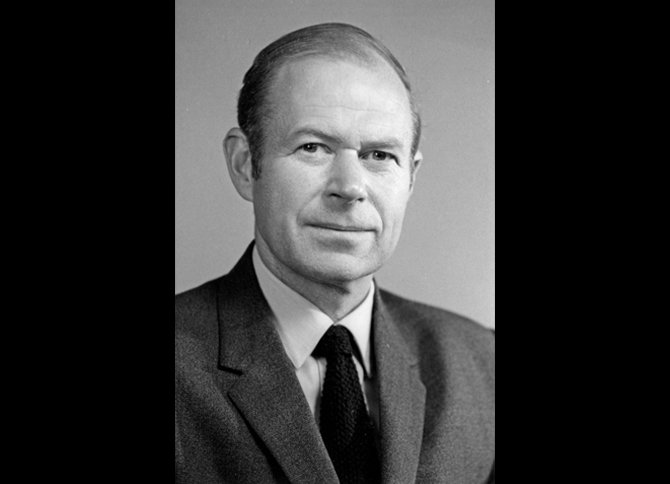Geoffrey Thornton’s lifelong interest was in the study of New Zealand’s engineering heritage and he was influential in gaining recognition for engineering and industrial heritage in New Zealand.

Geoffrey Thornton, 1950s or early 1960s
Early Years
Geoffrey was born in Kaponga, South Taranaki, on 17 July 1922. He was the second of three children, and only son of Onslow Garth Thornton and his wife Sarah Lily Chamberlain. Onslow Thornton was a civil engineer with the Public Works Department and served as District Engineer in Gisborne. During the school holidays, Geoffrey often accompanied his father on site visits as he surveyed for proposed engineering works or supervised works in progress, including the Kopu Bridge (1928) near Thames, and the Gisborne to Napier railway with its iconic Mohaka Viaduct. Geoffrey dates his interest in bridges to these early years through the 1920s and 1930s observing engineering projects his father was working on.
World War II
Geoffrey started his career with the Public Works Department in 1940, gaining a position in the Head Office in Wellington as an architectural cadet. In 1941 he joined the Territorial Force and went on to serve in WWII with the 6th Field Company Engineers in Egypt and Italy.
Architectural Studies
Returning to New Zealand after the war, he continued architectural studies, enrolling at Auckland University in 1946. Although Geoffrey passed all the written components of the course, he failed a studio drawing paper and his bursary was cancelled. This, combined with the extra stress placed upon him by his mother’s ill health, led him to leave university in 1949, before completing the programme. Instead he enrolled in the course run by the New Zealand Institute of Architects and continued his career with the Public Works Department, now renamed the Ministry of Works. He completed his architectural registration in 1955.
Ministry of Works Career
Through the 1950s Geoffrey worked as an architect for the Ministry of Works. He worked on sketch plans and drawings for the Whenuapai Airport and architectural design elements for the hydroelectric power station in Mangakino. In 1956 he was appointed the Ministry of Works architect in Wellington.
On 1 November 1958 Geoffrey married Jocelyn Margaret Henrici. The couple had three children.
Between 1960–1963 Geoffrey was the Ministry of Works Architect in Trentham and from 1965, Assistant District Architect in Dunedin. In 1973 he was promoted to Assistant Government Architect, Operations, based in Wellington, a position he held until his retirement in 1980.
Engineering Heritage
Although architecture rather than engineering was Geoffrey’s profession, his engineering interest was a constant undercurrent. During much of his career he worked closely with engineers while designing large public domain infrastructure projects. He also had a deep interest in heritage. Combining these two passions, Geoffrey represented the Ministry of Works (1971 to 1979), and later the New Zealand Institute of Architects (1979 to 1990), on the New Zealand Historic Places Trust Board, now Heritage New Zealand Pouhere Taonga. The Trust Board did not initially recognise engineering and industrial structures as heritage. Geoffrey argued for their inclusion and was instrumental in seeing the definition of heritage broaden to include the recognition and promotion of engineering heritage. Geoffrey served 19 years on the Trust Board, 14 of these as Chairman of the Trust’s Classification Committee.
Involvement with Engineering New Zealand
As well as the service he gave to the Historic Places Trust Board, Geoffrey also contributed much to the Institution of Professional Engineers (IPENZ), now Engineering New Zealand. He served on the IPENZ National Committee for Engineering Heritage from its formation in 1983 until 2009, providing the committee with his significant knowledge of heritage engineering. During this time, he was also a contributor to joint conferences held between IPENZ and the Institution of Engineers Australia.
In 1989, IPENZ undertook a project, “Engineering to 1990”, to commemorate some 68 of the most important engineering works. Geoffrey served on the committee for this project and nominated 40 sites, many of which were accepted.
Industrial and Engineering Heritage Publications
On his retirement from the Ministry of Works in 1980, Geoffrey pursued his heritage interests further, writing many important books on the subject, all wonderfully illustrated with his own photographs. These include: New Zealand’s Industrial Heritage (1982), The New Zealand Heritage of Farm Buildings (1986), Cast in Concrete: Concrete Construction in New Zealand 1850–1939 (1996) and Bridging the Gap: Early Bridges in New Zealand 1830–1939 (2001). Geoffrey’s last heritage-related book was Worship in the Wilderness: Early Country Churches of New Zealand (2003), demonstrating that his heritage knowledge and contribution went beyond industrial and engineering heritage.
Honours and Awards
Geoffrey was awarded an MBE in 1989 in recognition of his work to bring attention to and preserve New Zealand’s architectural heritage. The Historic Places Trust awarded him an Honorary Life Membership in 1990, a Certificate of Appreciation in 2002, and a 50th anniversary Heritage Award in 2005. His work with IPENZ was also officially recognised, and he was made an Honorary Fellow in 2000. In 2014, the University of Auckland’s Dean of Engineering, Professor Nic Smith, presented Geoffrey with a University of Auckland certificate recognising his enormous contribution to the recording of New Zealand’s engineering history.
Industrial and Engineering Heritage Books by Geoffrey Thornton
New Zealand’s Industrial Heritage. Wellington: Reed, 1982.
The New Zealand Heritage of Farm Buildings. Auckland: Reed Methuen, 1986.
Cast in Concrete: Concrete Construction in New Zealand 1850–1939. Auckland: Reed, 1996.
Bridging the Gap: Early Bridges in New Zealand 1830–1939. Auckland: Reed, 2001.
Worship in the Wilderness: Early Country Churches of New Zealand. Auckland: Reed, 2003.
